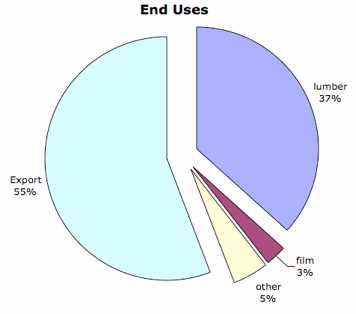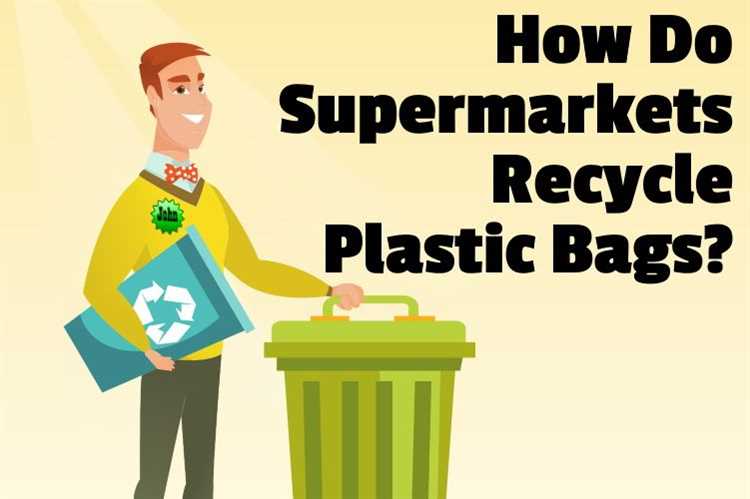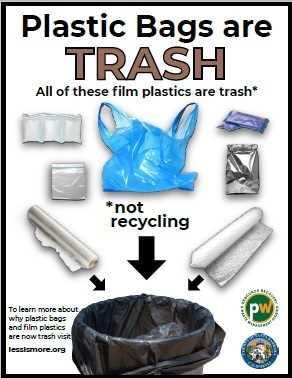
Plastic bags have become an integral part of our daily lives. They are lightweight, convenient, and widely used for shopping and packaging purposes. However, increasing concerns about their environmental impact and the need for sustainable practices have raised the question: Do plastic bags actually get recycled?
Recycling is often touted as the solution to our plastic waste problem. It is a process that involves collecting, sorting, and processing used materials to be converted into new products. In theory, plastic bags can be recycled and transformed into various items such as new bags, containers, or even furniture. However, the reality is far more complex.
The recycling process for plastic bags faces numerous challenges. First and foremost, plastic bags are often contaminated with food waste, grease, or other non-recyclable materials. This contamination makes it difficult and costly to separate and clean the bags for recycling.
- The Lifecycle of Plastic Bags
- Challenges in Plastic Bag Recycling
- Recycling Programs and Infrastructure
- Alternatives to Plastic Bags
- 1. Reusable Bags
- 2. Paper Bags
- Environmental Impact of Plastic Bag Recycling
- Consumer Awareness and Responsibility
- Consumer Advocacy
- Q&A:
- Are plastic bags really recyclable?
- What happens to plastic bags after they are collected?
- What are the challenges in recycling plastic bags?
- Why is the recycling rate for plastic bags low?
- What can individuals do to help increase the recycling rate for plastic bags?
- Are plastic bags actually recyclable?
- What happens to plastic bags after they are collected for recycling?
The Lifecycle of Plastic Bags
Plastic bags go through several stages in their lifecycle, starting from the production of raw materials to their eventual disposal or recycling.
1. Extraction: The first stage is the extraction of raw materials. Plastic bags are typically made from petroleum, a non-renewable fossil fuel. Oil drilling or fracking processes are used to extract the necessary petroleum.
2. Production: After extraction, the petroleum is refined and processed to create polymers, which are the basic building blocks of plastic bags. These polymers are then melted and shaped into thin film sheets, which will later be cut and sealed to form the bags.
3. Distribution and Use: Once produced, plastic bags are distributed to retailers and consumers for use. They are commonly used for carrying groceries, clothing, and other items. However, their convenience and low cost have also led to their widespread use and subsequent environmental issues.
4. Waste and Pollution: Many plastic bags end up as waste after a single use and are disposed of improperly. They can become litter and contribute to pollution, especially in oceans and waterways, where they can harm marine life and ecosystems. Plastic bags are known for their durability, taking hundreds of years to decompose.
5. Recycling: Plastic bags can be recycled, but the recycling rate is relatively low. Recycling facilities sort and process plastic bags, turning them into new plastic products such as shopping bags, decking, and plastic lumber. However, the complex recycling process and lack of proper recycling infrastructure contribute to the low recycling rate.
6. Landfill or Incineration: If plastic bags are not recycled, they end up in landfills or incinerators. In landfills, they can take up valuable space and release harmful chemicals as they break down over time. Incineration can also release toxic pollutants into the air, contributing to air pollution and climate change.
Understanding the lifecycle of plastic bags highlights the need for reducing their consumption, promoting proper disposal, and encouraging the use of reusable alternatives. By making conscious choices, we can mitigate the environmental impact of plastic bags and work towards a more sustainable future.
Challenges in Plastic Bag Recycling
Although plastic bags can technically be recycled, there are several challenges that make the process difficult and costly. One of the main challenges is the low recycling rate of plastic bags. Despite the fact that many recycling programs accept plastic bags, the percentage of bags that actually get recycled is quite low.
One reason for this low recycling rate is the lack of convenient recycling options for consumers. Many recycling centers do not accept plastic bags, and those that do often require the bags to be clean and free of any other materials. This can be inconvenient for consumers who may not have easy access to a recycling center or who may not realize that plastic bags need to be separated from other recyclables.
Another challenge is the lightweight nature of plastic bags. During the recycling process, lightweight items like plastic bags can become tangled in sorting machinery, leading to costly equipment breakdowns and delays. To prevent this, recycling facilities must invest in specialized sorting equipment, which can be expensive.
Furthermore, plastic bags are often contaminated with food residue or other substances, making them difficult to recycle. The presence of contaminants can reduce the quality of the recycled material, making it less desirable for manufacturers. This can result in a limited market for recycled plastic bag material, further reducing the incentive to recycle.
In addition, the low cost of producing new plastic bags compared to recycling them makes it less economically viable for recycling facilities to invest in the necessary infrastructure. As a result, many plastic bags end up in landfills or as litter, contributing to environmental pollution and waste.
Efforts are being made to tackle these challenges and increase plastic bag recycling rates. Some cities and states have implemented legislation to ban or impose fees on plastic bags, encouraging consumers to use reusable alternatives instead. Additionally, education campaigns are being launched to raise awareness about the importance of recycling and proper disposal of plastic bags.
| Challenges | Solutions |
|---|---|
| Low recycling rate | Improve accessibility and convenience of recycling options |
| Tangling in sorting machinery | Invest in specialized sorting equipment |
| Contamination with food residue | Educate consumers about proper disposal and improve sorting processes |
| Low economic incentive | Implement legislation to encourage reusable alternatives |
Addressing these challenges will be crucial in order to promote plastic bag recycling and reduce the environmental impact of plastic waste.
Recycling Programs and Infrastructure

Recycling programs and infrastructure play a crucial role in determining the success of plastic bag recycling. The effectiveness of these programs relies on a combination of factors, including government policies, public participation, and the availability of recycling facilities.
Many countries and municipalities have implemented recycling programs specifically targeted at plastic bags. These programs often involve dedicated collection bins or drop-off points where consumers can dispose of their used plastic bags. Some areas even offer curbside collection services, making it more convenient for individuals to recycle their bags.
In addition to collection programs, the presence of recycling facilities is essential for the successful recycling of plastic bags. These facilities are responsible for sorting and processing the collected bags, transforming them into reusable materials. Depending on the technology and infrastructure available, the recycling process can be mechanical (using shredding and melting) or chemical (using solvents to break down the plastic).
However, not all recycling programs and infrastructure are equal. The success of plastic bag recycling depends on the efficiency and effectiveness of these systems. Some areas may lack proper infrastructure, leading to less efficient recycling processes or limited capacity to handle large quantities of plastic bags. As a result, some plastic bags may end up being improperly disposed of or sent to landfill.
It is worth noting that not all plastic bags can be easily recycled. Certain types of plastic, such as those used in food packaging or bags with multiple layers, can present challenges in the recycling process. These bags may require specialized facilities or technologies to be properly recycled, further emphasizing the importance of having adequate infrastructure in place.
To address these challenges, governments and organizations are increasingly investing in improving recycling programs and infrastructure for plastic bags. This includes initiatives to educate the public about proper recycling practices, research and development to enhance recycling technologies, and collaborations between government agencies, businesses, and recycling facilities.
Overall, recycling programs and infrastructure play a significant role in determining the fate of plastic bags. By improving these systems and increasing public participation, it is possible to achieve higher recycling rates and reduce the environmental impact of plastic bag waste.
Alternatives to Plastic Bags
Plastic bags have become a major environmental concern due to their non-biodegradable nature and detrimental impact on marine life and ecosystems. Fortunately, there are several alternatives to plastic bags that are more sustainable and eco-friendly. These alternatives provide a viable solution to reducing plastic waste and protecting the environment.
1. Reusable Bags
One of the most effective alternatives to plastic bags is using reusable bags. These bags are typically made from materials such as cotton, jute, or canvas, which are biodegradable and can be used multiple times. Reusable bags are durable, convenient, and come in various sizes and designs. By using reusable bags, individuals can significantly reduce their plastic waste and contribute to a cleaner environment.
2. Paper Bags
Paper bags are another alternative to plastic bags. They are made from renewable resources and are easily recyclable. While paper bags do have a lower environmental impact compared to plastic bags, they still require significant amounts of energy and resources to produce. However, many paper bags are now made from recycled materials, further reducing their environmental footprint. It is important to recycle paper bags after use to ensure maximum sustainability.
Overall, by opting for reusable bags or paper bags instead of plastic bags, individuals can play an active role in reducing plastic pollution. It is important to choose sustainable alternatives and be mindful of our consumption habits to protect the environment and wildlife for future generations.
Environmental Impact of Plastic Bag Recycling

While recycling plastic bags can help to reduce the amount of waste that ends up in landfills or natural environments, it also has its environmental consequences. Here are some key points to consider regarding the environmental impact of plastic bag recycling:
- Energy Consumption: The recycling process requires energy, which is typically generated through the burning of fossil fuels. This combustion contributes to greenhouse gas emissions and air pollution.
- Water Usage: Recycling plastic bags involves various water-intensive processes, such as cleaning, sorting, and processing. The excessive use of water for recycling can strain local water resources and contribute to water scarcity issues.
- Transportation Emissions: Moving plastic bags from collection points to recycling facilities often involves transportation, which can lead to the emission of greenhouse gases and contribute to air pollution.
- Chemical Usage: Some recycling methods and processes for plastic bags require the use of chemicals, such as solvents and detergents. These chemicals can be harmful both to the environment and to the workers involved in the recycling process.
- Recycling Infrastructure: Establishing and maintaining recycling facilities for plastic bags requires resources, including land, energy, and funding. The construction and operation of these facilities can have their own environmental impact, such as land degradation and resource depletion.
It is important to acknowledge that while recycling plastic bags can be beneficial in terms of waste reduction, it is not a perfect solution and comes with its own set of environmental trade-offs. To truly address the plastic bag waste problem, it is necessary to also focus on reducing plastic bag consumption, promoting reusable alternatives, and supporting sustainable and circular economy practices.
Consumer Awareness and Responsibility
Consumer awareness and responsibility play a crucial role in addressing the issue of plastic bag recycling. As consumers, we must be aware of the environmental impact of single-use plastic bags and take responsibility for our choices and actions.
One of the first steps in increasing consumer awareness is education. It is important to inform the public about the negative consequences of plastic bag usage, such as pollution and harm to wildlife. This can be done through public campaigns, school programs, and informative materials at grocery stores and other retail outlets.
Consumer responsibility also involves making conscious decisions. Instead of accepting plastic bags at checkout, consumers can choose reusable alternatives such as cloth bags or tote bags. By reducing the demand for plastic bags, we can decrease their production and ultimately reduce waste.
In addition to using reusable bags, consumers can also support businesses that have implemented plastic bag recycling programs. These programs encourage customers to return their used plastic bags to designated collection points, where they can be properly recycled. By supporting these initiatives, consumers can help ensure that plastic bags are diverted from landfills and given a second life.
Consumer Advocacy
Consumers also have the power to advocate for change. By voicing concerns to retailers, local governments, and other stakeholders, we can pressure them to implement more sustainable practices. This might include charges for single-use plastic bags, promoting the use of reusable bags, or supporting legislation that regulates plastic bag usage.
It is crucial for consumers to be mindful of their choices and take responsibility for their actions when it comes to plastic bag usage. By being aware of the environmental impact, making conscious decisions, supporting recycling programs, and advocating for change, consumers can contribute to a healthier and more sustainable future for our planet.
Q&A:
Are plastic bags really recyclable?
Yes, plastic bags can be recycled, but the recycling rate is relatively low.
What happens to plastic bags after they are collected?
After collection, plastic bags are taken to a recycling facility where they are sorted, cleaned, and processed into plastic pellets. These pellets can then be used to make new products.
What are the challenges in recycling plastic bags?
One of the main challenges in recycling plastic bags is contamination. If plastic bags are mixed with other recyclables or non-recyclable items, it can negatively affect the recycling process. Additionally, not all recycling facilities have the capability to recycle plastic bags.
Why is the recycling rate for plastic bags low?
The recycling rate for plastic bags is low for several reasons. Many people do not properly recycle plastic bags, and they end up in landfills or littering the environment. Some recycling facilities do not accept plastic bags, and others that do may face challenges in the recycling process.
What can individuals do to help increase the recycling rate for plastic bags?
Individuals can help increase the recycling rate for plastic bags by properly recycling them. This includes taking plastic bags to designated recycling drop-off locations or using collection programs offered by grocery stores. It is also important to reduce the use of plastic bags by choosing reusable alternatives whenever possible.
Are plastic bags actually recyclable?
Yes, plastic bags are technically recyclable. However, the reality is that many plastic bags end up in landfills or as litter, rather than being recycled.
What happens to plastic bags after they are collected for recycling?
After plastic bags are collected for recycling, they are typically sent to a recycling facility. There, they are sorted, cleaned, and processed into tiny plastic pellets. These pellets can then be used to make new plastic bags or other plastic products.